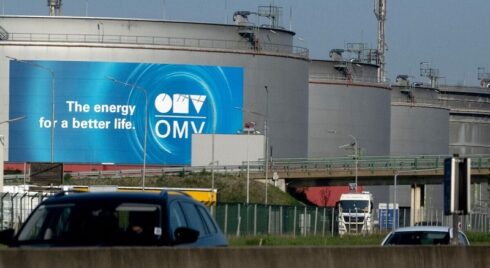Written by Ahmed Adel, Cairo-based geopolitics and political economy researcher
Austria is “overflowing” with Russian natural gas, which allows long-time customers of Russian state corporation Gazprom to increase sales to its neighbours, Bloomberg reported. The outlet added that the flow from Russia represents more than half of Austria’s demand, which is only taking timid steps to diversify its gas sources. It appears that despite the harsh rhetoric against Russia, Austria will not allow itself to suffer like neighbouring Germany.
As a hub for Russian flows for over half a century, the country has storage depots and pipelines historically set up to route fuel to Germany, Slovenia, Hungary and Italy, and Austrian state-owned company OMV AG has a contract with Gazprom until 2040. The Central European country has said it wants to diversify away from Russia, but trade data shows a steady flow through a pipeline from Ukraine that meets more than half of the economy’s demand.
However, Walter Boltz, a former Austrian regulator and current senior energy consultant at Baker & Mckenzie LLP, said he is increasingly alarmed by this so-called failure to diversify as Ukraine’s gas transport contract with Russia expires in December 2024, and Kiev has committed not to negotiate a new agreement with Russia.
The Bloomberg article also revealed a concern about the lack of work on the construction of alternative pipelines, as the €200 million WAG LOOP 1, which could supply 27 tW/h of gas, equivalent to around a third of Austria’s annual demand, is not expected to be ready until 2027, due to problems related to the failure to deliver the environmental licenses necessary for its extension.
Boltz and Gas Connect Austria believe the country can meet demand in 2025 even without supplies from Russia, but there is still the issue of prices, which will remain high without further connections.
“The risk in 2025 and 2026 is not so much that there will be no gas available, but that prices could again be quite high,” said the consultant at Baker & Mckenzie LLP, adding that another price crisis needs to be avoided.
However, Austria is not the only country in Europe to continue receiving Russian gas. It is recalled that Gazprom CEO Alexey Miller said in November that despite the European refusal of Russian gas, it continues to flow in significant quantities.
“I wouldn’t like to mention any numbers because the molecules in the pipeline have no national colour,” he said in response to a question about the percentage of Russian gas Europe receives, adding that major deliveries continue.
“The President of the Russian Federation, Vladimir Putin, very recently gave the example of a centre in Austria, Baumgarten. We are currently supplying gas to Baumgarten, which is a large European centre from which gas is supplied to other countries in the European Union,” the CEO continued.
Several European countries partially or completely lost gas from Gazprom in 2022 as the company cut or stopped supplies to Bulgaria, Poland, Finland, the Netherlands, Germany, and Denmark, mainly citing non-compliance with a presidential decree on payment in rubles or other technical reasons.
Months later, deliveries along the main route via the Nord Stream were stopped. Pumping via the Belarusian Yamal-Europe route has also been halted, while the Ukrainian route has also seen a significant decline. As a result, Russian pipeline gas is now supplied to Europe through one of the two entry points of the Ukrainian gas transportation system and through Turkey, where it arrives via the TurkStream.
Europe’s quest to diversify away from Russian gas has only sent prices sky-high and exposed the continent to shortages and risks, especially Germany.
The chief of RWE, one of Germany’s largest energy companies, said Europe needed to boost its capacity to import gas to ensure it could cope with any unexpected outages on pipelines or import terminals.
Speaking to the Financial Times, RWE CEO Markus Krebber said: “[Europe is] not where we need to be because we shouldn’t have an energy supply system which is without any margin or buffer.” His warning came despite Europe entering winter with gas stocks about 99% full after a major effort to fill them up over the summer to cope with supply cuts from Russia.
The situation is so bad in Germany that Economy Minister and Deputy Chancellor Robert Habeck cancelled his scheduled appearance at the COP28 climate summit in Dubai on December 4 so that he could focus on the government’s negotiations for a 2024 budget after its original spending plans were deemed illegal by the constitutional court.
Berlin recently suspended the debt brake for 2023 to cover funds like energy subsidies and flood relief payments that the constitutional court also deemed illegitimate, with the money already spent. This comes as unemployment reaches a two-year high, the cost-of-living skyrockets and inflation remains stubbornly high. Austria continues pumping Russian gas in massive quantities so that it can avoid the very situation that Germany is suffering from, even if leaders in Vienna continue speaking out against Moscow.







the more time passes, the more strongly it is noticed in europe that russia and the brics control a significant part of the natural resources. in the end, you can’t afford to exaggerate anymore. behind the sanctions was the fear of the brics overrunning the power of the dollar and the euro. and thus the dollar’s ability to blackmail developing countries. because of the sanctions, the brics got stronger. without sanctions, they might not have been realized otherwise.